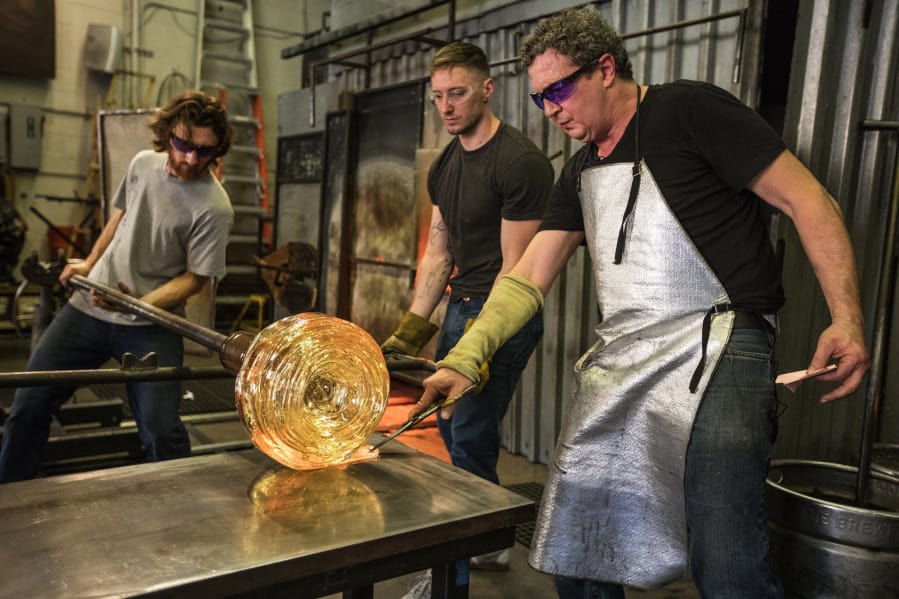SEATTLE — It’s a delicate, dangerous and blazing-hot dance being orchestrated by Seattle glass sculptor Martin Blank.
He wears a Kevlar apron and leather gloves to protect from the sweltering heat radiating from ovens used to store and shape glass art. He weaves expertly among a team of artists he has assembled in his South Lake Union shop, shouting orders over the roar of the furnace.
“Pour! Pour! That’s right,” he yells to a man ladling strips of liquid glass with a huge metal spoon onto a small rolling table. The 1,600-square-foot studio where the sculpture is taking shape is filled with shears, tweezers, paddles, mitts and cooling buckets of water.
Blank is a glass artist known for a massive installation, “Fluent Steps,” that runs the entire length of the 210-foot plaza outside the Tacoma Museum of Glass. He’s creating the final piece, or what he calls his “one last big blow,” at the hot shop he has owned for 20 years.
The studio, like so many other bastions of old Seattle driven away by the rising costs of land and increasing congestion, is being torn down to make way for the new. By August, the building that houses the shop will be demolished, and construction will begin on a 28-story luxury apartment tower. It’s part of the transformation that this Seattle neighborhood has been undergoing since 2008, an urban space that locals have come to call “Amazonia,” in reference to retailer Amazon’s establishment and expansion of its headquarters that employ more than 40,000 people.
“Change is intense. It’s hard. It’s bittersweet. But I’m OK with it,” says Blank, beads of sweat running down his face, neck and arms during a May 22 interview in his shop. He has been called one of “America’s significant figurative sculptors” by artdaily.org.
“In some ways, it’s going to be a relief. Seattle is not what it used to be, and it’s time to leave,” he adds.
Blank has a private studio in Ballard where he plans to work on smaller pieces. In a year, he’ll decide if he needs a bigger workshop, he says.
Although there are many other glassblowing rental studios in Seattle — the Puget Sound has the largest conglomeration of glass artists in the country, according to Whidbey Island-based glass artist Fritz Dreisbach — Blank’s studio is unique in many ways. His is the only one in Seattle that rents space and equipment to artists and also has the capacity to handle massive pieces of glass that require a long, slow cooling process. The biggest risk to glass-art pieces is the possibility of cracking.
No other studio in the region has quite the pedigree of Blank’s. The shop has been used by big-name artists such as Lino Tagliapietra, Pino Signoretto and Dale Chihuly. Chihuly, who built a museum and outdoor glass-art gallery just yards away from the Space Needle, worked with Blank for 12 years.
Blank, who grew up just outside of Boston, came to the Seattle area in 1985 to attend Pilchuck Glass School in Stanwood. He fell in love with the region and, like many others during that time, chose to make it home.
He says he never did well in a traditional school setting because he’s dyslexic. Instead, he found solace and inspiration during weekly visits to the Museum of Fine Arts in Boston. Now, one of his proudest achievements is that his work is on display in a permanent collection at the museum where he found his calling.
Dreisbach says Blank has been one of the glass art scene’s most important role models.
“Martin is one of the most helpful, kind and considerate people I’ve ever been around,” Dreisbach says. “He’s an inspiration to young people and he’s a good example for old farts like me who need to see you can be excellent and a famous artist without having to be an a-hole.”
Back at the shop, one of the half-dozen glass artists assisting Blank uses a metal pole to roll up a delicate strip of glass. Another uses a flamethrower to heat the glass stem to which the roll will be attached.
The final creation is about three feet across and weighs a hundred pounds. He says it’s inspired by so-called Fresnel lenses in lighthouses and tree rings. He calls it “Light Ring.”
“It’s a metaphor for my own life, for change and for growth,” says Blank.
Blank had called together a half-dozen artists that he’d worked with over the years to collaborate on “Light Ring.” Some longtime friends and admirers, as well as new artists, are in attendance to bear witness.
“It feels like I’m watching history,” says Los Angeles-based artist Kate Haigney. “Martin is one of the pioneers of the American glass scene.”
After hours of hot, sweaty work, Blank declares the sculpture “perfect.”
Moments later, it cracks under its own weight. All the work — the glass, the silver leaf layered into the piece — is ruined.
But that’s the breaks of a glass artist, he says. He and his team take 15 minutes to cool off and talk about what went wrong before they start again.
Three hours later, their second effort is a win.
“This is how it is,” Blank says. “You try something. If it doesn’t work, you try again and you just keep going and you keep trying and you keep experimenting until you get it right.”



